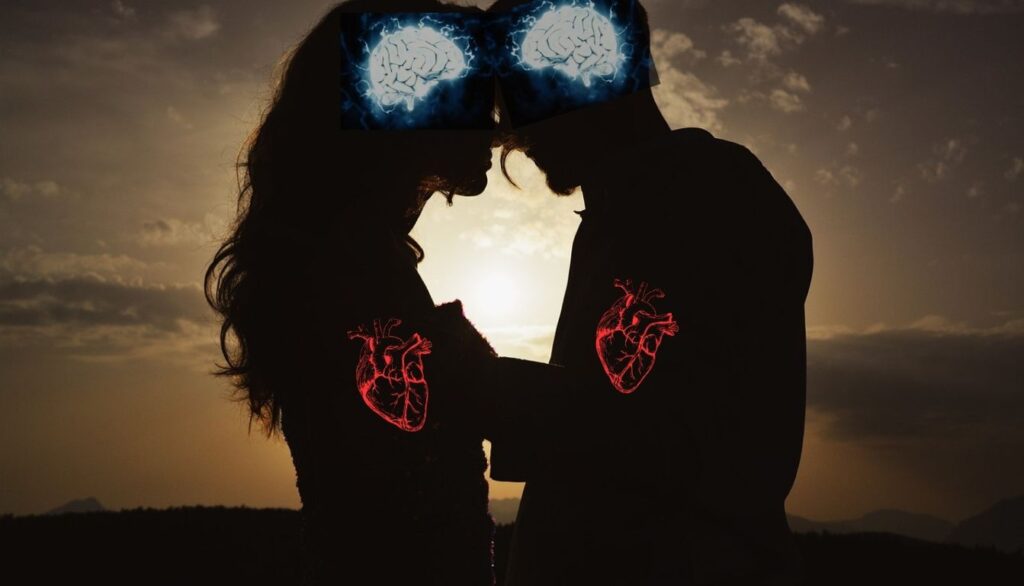Love at first sight is a fascinating phenomenon, which has always aroused the curiosity of poets, philosophers, psychologists and scientists.
Love at first sight is when the heart speaks before the mind can say anything.
👉 What happens in our brain when we fall in love at first sight? What are the biological, hormonal and chemical mechanisms that trigger this irresistible attraction? What are the consequences on our behavior, our mood, our health? Here are some answers, based on the latest discoveries in neuroscience.
Romantic relationships: how neuroscience helps us better understand love at first sight 🧠
The statistical probability: 0.2 seconds to fall in love at first sight 😮
Love at first sight is a fiery fire that consumes everything in its path, giving way to a vibrant and unforgettable love.
👉 Love at first sight is a quick and intense reaction According to a study conducted by researchers at Syracuse University in the United States, it only takes 0.2 seconds to fall in love at first sight.
Indeed, love at first sight is a rapid and intense reaction, which involves several areas of the brain, including the anterior cingulate cortex, the insular cortex, the amygdala, the hippocampus, the ventral striatum and the nucleus accumbens.
These regions are linked to emotions, memory, motivation, pleasure and reward.
Love at first sight is an explosion of neurotransmitters 💥
When we experience a lightning strike, our brain releases a large amount of neurotransmitters, that is, chemical molecules that transmit signals between neurons. These neurotransmitters include dopamine, norepinephrine, serotonin, oxytocin and endorphins. These substances have various effects on our body, such as:
- Dopamine: it stimulates the pleasure and reward center, which gives us a feeling of well-being, euphoria, excitement and self-confidence. It also increases our attention, concentration, creativity and memory.
- Norepinephrine: It activates the sympathetic nervous system, which increases our heart rate, breathing, blood pressure and sweating. It also strengthens our alertness, our reactivity, our energy and our motivation.
- Serotonin: it regulates our mood, our sleep, our appetite, our libido and our body temperature. It makes us happier, more optimistic, more sociable and more attached to our partner.
- Oxytocin: it promotes emotional bonding, trust, loyalty, tenderness, cuddling and orgasm. It also reduces stress, anxiety, fear and pain.
- Endorphins: they provide a feeling of pleasure, relaxation, satisfaction and relief. They also reduce sadness, anger, frustration and depression.
Love at first sight affects around 50% of people
He is a unique and universal experience, which affects around 50% of people at least once in their life, according to an Ifop survey carried out in 2019. There are no rules or criteria for falling in love at first sight, it can happen at any time, at any age, in any gender, in any culture, in any situation.
Love at first sight is unpredictable
“Love at first sight is not rational, it is a mysterious phenomenon that defies all logic.
It is often unpredictable, unexpected, inexplicable, but it is also powerful, deep, sincere and lasting.
According to the same survey, 72% of people who have experienced love at first sight are still with their partner, or have been for more than 10 years.
Love at first sight is more than a feeling
He is therefore a complex and fascinating phenomenon, which reveals to us the mysteries of our brain and our heart. It shows us that love is more than a feeling, it is an alchemy, a magic, an adventure.
He invites us to let ourselves be surprised, to open up to others, to flourish in the relationship. It reminds us that love is the most beautiful gift, and that we must savor it, cultivate it, protect it.
Signs of love at first sight: women and men
Love at first sight is like an explosion of feelings that takes you into a whirlwind of indescribable emotions.
- Increased heart rate: An increased heart rate is often observed during a lightning strike, due to activation of the sympathetic nervous system.
- Sweating and Feeling Hot: A common physiological reaction, increased sweating and feeling hot can accompany the emotional excitement of love at first sight.
- Difficulty concentrating: The intensity of emotions felt during a crush can make it difficult to concentrate on other tasks or thoughts.
- Feeling euphoric: Love at first sight is often associated with a feeling of well-being, euphoria and excitement, caused in part by the release of dopamine in the brain.
- Obsessive thoughts: Thoughts of the loved one can occupy a large part of the mind of the person falling in love, often obsessively.
- Deep feeling of connection: He can bring about an immediate feeling of connection and familiarity with your loved one, as if they were destined to be important in your life.
- Loss of appetite or sleep disturbances: Some individuals may experience loss of appetite or sleep disturbances due to excitement and anxiety related to love at first sight.
- Involuntary smile: A spontaneous and irresistible smile can appear on the face of a person caught in the torments of love at first sight.
- Heightened sensitivity to emotions: Emotions can be experienced more intensely and deeply during love at first sight, with highs and lows often exacerbated.
Specific signs of love at first sight in women:
- Intense and prolonged gaze: A woman caught in the torments of love at first sight may maintain prolonged eye contact with the person who has captivated her, thus expressing her interest and attraction.
- Radiant Smile: A bright, warm smile can light up a woman’s face when she is in love at first sight, reflecting her joy and excitement.
- Open body language: A woman in love may adopt open, receptive body language, leaning forward slightly, making gentle gestures, and subtly touching her hair or face.
- Attentive Listening: She may be particularly attentive to her loved one’s words, showing sincere interest in what they are saying and asking questions to deepen the conversation.
- Spontaneous laughter: Spontaneous, joyous bursts of laughter can be common when the woman feels a strong connection with the person who has captured her heart.
- Nervous behavior: Despite her apparent charm, a woman in love at first sight may also exhibit signs of nervousness, such as blushing, slight stuttering or awkward gestures.
- Projection into the future: She can express thoughts about the future with her loved one, imagining scenarios where they are together and sharing common projects.
- Intense Emotions: The emotions a woman feels during love at first sight can be particularly intense and deep, with highs and lows that reflect her emotional commitment.
The duration of love at first sight
The duration can vary from person to person and often depends on several factors, including the depth of emotions felt, the circumstances surrounding the meeting, and the compatibility between the individuals involved.
For some, love at first sight can be a fleeting experience, dissipating quickly after the first meeting. For others, it can evolve into deeper, lasting love, leading to lasting, meaningful relationships.
👉 Some researchers suggest that the biochemical effects of love at first sight, such as the release of neurotransmitters such as dopamine, norepinephrine, serotonin, oxytocin, and endorphins, may initially elicit feelings of excitement and euphoria that may fade over time. However, if a deeper emotional and intellectual connection develops between the people involved, love at first sight can evolve into a more stable and lasting relationship.
🤔 It is also important to note that love at first sight can be a recurring phenomenon, occurring multiple times throughout a person’s life with different people. In these cases, the duration of each crush can vary depending on the strength and durability of the feelings involved.
Conclusion
In conclusion, the exploration of the phenomenon of love at first sight highlights its complex neurological, hormonal and chemical mechanisms. The release of neurotransmitters like dopamine, serotonin, and oxytocin in the brain during this experience induces feelings of euphoria and connection.
In addition, the discussion around the variability of its duration highlights its importance in relationships. Additionally, delineating common symptoms, including increased heart rate and euphoria, as well as specific signs seen in women, such as prolonged eye contact and open body language, provides insight into this phenomenon. captivating.




